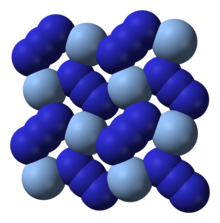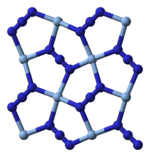
Silver azide

| |
| Names | |
|---|---|
|
IUPAC name
Silver(I) azide
| |
| Other names
Argentous azide
| |
| Identifiers | |
|
3D model (JSmol)
|
|
| ChemSpider |
|
| ECHA InfoCard | 100.034.173 |
|
PubChem CID
|
|
| UNII | |
|
CompTox Dashboard (EPA)
|
|
| |
| |
| Properties | |
| AgN3 | |
| Molar mass | 149.888 g/mol |
| Appearance | colorless crystals |
| Density | 4.42 g/cm3 |
| Melting point | 250 °C (482 °F; 523 K) explosive |
| Boiling point | decomposes |
| Solubility in other solvents | 2.0×10−8 g/L |
| Structure | |
| Orthorhombic oI16 | |
| Ibam, No 72 | |
| Hazards | |
| Occupational safety and health (OHS/OSH): | |
|
Main hazards
|
Very toxic, explosive |
| NFPA 704 (fire diamond) | |
|
Except where otherwise noted, data are given for materials in their standard state (at 25 °C [77 °F], 100 kPa).
| |
Silver azide is the chemical compound with the formula AgN3. It is a silver(I) salt of hydrazoic acid. It forms a colorless crystals. Like most azides, it is a primary explosive.
Structure and chemistry
Silver azide can be prepared by treating an aqueous solution of silver nitrate with sodium azide. The silver azide precipitates as a white solid, leaving sodium nitrate in solution.
X-ray crystallography shows that AgN3 is a coordination polymer with square planar Ag+ coordinated by four azide ligands. Correspondingly, each end of each azide ligand is connected to a pair of Ag+ centers. The structure consists of two-dimensional AgN3 layers stacked one on top of the other, with weaker Ag–N bonds between layers. The coordination of Ag+ can alternatively be described as highly distorted 4 + 2 octahedral, the two more distant nitrogen atoms being part of the layers above and below.
 |
 |
 |

|
| Part of a layer | Layer stacking | 4 + 2 coordination of Ag+ | 2 + 1 coordination of N in N−3 |
In its most characteristic reaction, the solid decomposes explosively, releasing nitrogen gas:
- 2 AgN3(s) → 3 N2(g) + 2 Ag(s)
The first step in this decomposition is the production of free electrons and azide radicals; thus the reaction rate is increased by the addition of semiconducting oxides. Pure silver azide explodes at 340 °C, but the presence of impurities lowers this down to 270 °C. This reaction has a lower activation energy and initial delay than the corresponding decomposition of lead azide.
Safety
AgN3, like most heavy metal azides, is a dangerous primary explosive. Decomposition can be triggered by exposure to ultraviolet light or by impact.Ceric ammonium nitrate [NH4]2[Ce(NO3)6] is used as an oxidising agent to destroy AgN3 in spills.
See also
|
Silver compounds
| |||
|---|---|---|---|
| Silver(0,I) | |||
| Silver(I) |
|
||
| Silver(II) | |||
| Silver(III) | |||
| Silver(I,III) | |||
|
Salts and covalent derivatives of the azide ion
| ||||||||||||||||||||||||||||||||||||||||||||||||||||||||||||||||||||||||||||||||||||||||||||||||||||||||||||||||||||||||||||||||||||||||||||||||||||||||||||||||||||
|---|---|---|---|---|---|---|---|---|---|---|---|---|---|---|---|---|---|---|---|---|---|---|---|---|---|---|---|---|---|---|---|---|---|---|---|---|---|---|---|---|---|---|---|---|---|---|---|---|---|---|---|---|---|---|---|---|---|---|---|---|---|---|---|---|---|---|---|---|---|---|---|---|---|---|---|---|---|---|---|---|---|---|---|---|---|---|---|---|---|---|---|---|---|---|---|---|---|---|---|---|---|---|---|---|---|---|---|---|---|---|---|---|---|---|---|---|---|---|---|---|---|---|---|---|---|---|---|---|---|---|---|---|---|---|---|---|---|---|---|---|---|---|---|---|---|---|---|---|---|---|---|---|---|---|---|---|---|---|---|---|---|---|---|---|
| ||||||||||||||||||||||||||||||||||||||||||||||||||||||||||||||||||||||||||||||||||||||||||||||||||||||||||||||||||||||||||||||||||||||||||||||||||||||||||||||||||||
